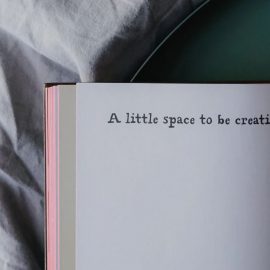

This article is an excerpt from the Shortform book guide to "Set Boundaries, Find Peace" by Nedra Glover Tawwab. Shortform has the world's best summaries and analyses of books you should be reading.
Like this article? Sign up for a free trial here.
What is Nedra Glover Tawwab’s Set Boundaries, Find Peace about? What is the key message to take away from the book?
In her book Set Boundaries, Find Peace, therapist Nedra Glover Tawwab details how you can transform your relationships by learning to set healthy boundaries. Tawwab explains where your boundaries come from and offers strategies for identifying and communicating your boundaries in a variety of situations.
Below is a brief overview of Set Boundaries, Find Peace by Nedra Glover Tawwab.
Set Boundaries, Find Peace
The Set Boundaries, Find Peace book aims to empower you to improve your relationships by learning to set boundaries, which are standards for how you’d like to be treated. The author, Nedra Glover Tawwab, is a practicing clinical therapist and social worker who is well known for using her Instagram page to bring awareness to mental health topics.
In her book Set Boundaries, Find Peace, published in 2021, Tawwab argues that in order to maintain healthy relationships, you need to understand, set, and reinforce healthy boundaries in your relationships. Tawwab provides examples of both healthy and unhealthy boundaries and offers insight into common problems her clients experience while learning to set boundaries.
In our guide, we’ll first explain what healthy boundaries look like, as compared to boundaries that are too weak or too strict. Then, we’ll show you how to identify, set, and reinforce healthy boundaries in your relationships. Next, we’ll look at different types of relationships that can make boundary-setting difficult and offer strategies for these situations. Finally, we’ll discuss major and minor boundary violations and provide recommendations for how to respond when your boundaries are violated. We’ll also provide insight into the psychological research that shapes Tawwab’s work, while offering contrasting opinions from other mental health professionals and researchers.
Healthy Boundaries and Unhealthy Boundaries
According to Tawwab, your boundaries are your standards for how you’d like to be treated in your relationships. They can be explicit or implicit. For example, you might explicitly set a boundary with your roommate that you expect them to stay out of your room while you’re on work calls. By contrast, you might implicitly expect your roommate to not take money from your wallet without asking. As Tawwab notes, our tendency to be either explicit or implicit about our boundaries is shaped by our childhood relationships with our parents. If your parents had many unspoken rules and expectations, then you’ll tend to have implicit boundaries, whereas if your parents clearly expressed their rules, you’ll be more likely to have explicit boundaries.
Tawwab believes that setting healthy boundaries allows you to feel safe and comfortable in your relationships. When you set boundaries, you make sure that the people in your life know how you’d like to be treated, which can make things more comfortable both for them and for you. On the other hand, if you don’t set boundaries, you’ll likely experience resentment, anxiety, and exhaustion in your relationships. Without boundaries, your friends, coworkers, and loved ones will fail to live up to your standards, as they won’t know what those standards are in the first place. Inevitably, you’ll be frustrated and disappointed when these failures happen.
Your boundaries are informed by your personal history. Depending on your past relationships, you might develop boundaries differently. Tawwab specifies two types of unhealthy boundaries that people often develop: weak boundaries and strict boundaries (or as Tawwab refers to them, porous boundaries and rigid boundaries).
Tawwab’s first type of unhealthy boundary, weak boundaries, are boundaries that are too flexible to protect your needs. Weak boundaries make it hard to say no to people, even when you’re already feeling overwhelmed. Other signs you may have weak boundaries include a desire to make everyone happy, fear of rejection, and needing approval from others.
For example, suppose you’d like one of your coworkers to contribute equally on shared projects, but you always end up covering for them as deadlines approach. While you’d rather not take on the extra work, you always agree to do it, out of a desire to help your coworker. In this scenario, you have a weak boundary with your coworker—because you’re unable to say no, you end up stretching yourself thin. As a result of the weak boundary, you overwork yourself, and you may even feel resentful toward your coworker.
If you weren’t allowed to prioritize your needs as a child, you may end up with weak boundaries as an adult. As Tawwab notes, this is especially common in adult children of parents who struggled with addiction.
Strict Boundaries
Strict boundaries are the second type of unhealthy boundary that Tawwab describes. Strict boundaries are the opposite of weak boundaries—they lead you to push people away in an attempt to keep yourself safe.
If you have strict boundaries, you might refuse to forgive friends for minor offenses and instead opt to cut them out completely. While cutting people out instead of working to set boundaries and resolve issues might keep those people from hurting you, setting such strict boundaries may lead you to lose friends and experience loneliness.
According to Tawwab, you might develop strict boundaries if others have taken advantage of you in the past. Strained relationships with family and friends who ask to borrow money, as well as a history of being taken advantage of in romantic relationships are common factors that can lead you to develop strict boundaries.
You may have strict boundaries if you experience fear of vulnerability, an inability to share, or you cut people out without first making an effort to repair the relationship.
Healthy Boundaries
In contrast to weak and strict boundaries, healthy boundaries allow you to prioritize your needs without pushing others away or allowing them to take advantage of you. You probably have healthy boundaries if you’re able to maintain close and comfortable relationships, you’re comfortable saying no, and you’re also comfortable when people in your life say no to you.
An example of healthy boundaries would be saying no to taking a friend to the airport in the middle of an especially busy workweek. If you have weak boundaries, you might stretch yourself thin by agreeing to the request, and if you have strict boundaries, you might consider stepping back from the relationship to avoid giving too much to the other person. However, if you have healthy boundaries, you’ll feel comfortable saying no to your friend while maintaining a positive relationship.
Tawwab believes that healthy boundaries develop when the trauma of past relationships doesn’t strongly affect your current ones. Of course, we’re always affected by our pasts to some degree, but if you have healthy boundaries, you’re also likely to be relating to your past in a healthy way.
How to Set Boundaries
Now that we know what healthy boundaries look like, let’s focus on how to set healthy boundaries. According to Tawwab, setting boundaries is a three-step process. First, identify the boundaries you’d like to set. Second, clearly communicate those boundaries. Finally, take action to reinforce your boundaries.
Step 1: Identify Your Boundaries
As Tawwab describes, before you can communicate your boundaries to others, you’ll need to identify the boundaries you’d like to set. There are two categories of boundaries you’ll want to consider: personal boundaries and social boundaries.
According to Tawwab, your personal boundaries are your standards for how people should treat your physical body. Personal boundaries specify what level of physical and sexual contact, if any, you’re comfortable with in your relationships.
To identify your personal boundaries, reflect on a situation where physical touch made you uncomfortable. Ask yourself what specifically made you uncomfortable and how you’d like to be treated in the future. Once you’ve identified a situation where you’d like to set a personal boundary, define the boundary by writing down a statement that includes both the behavior that makes you uncomfortable and what changes you’d like to see.
For example, Tawwab writes that if you notice that you like hugging friends but not people you’ve only recently met, you may have identified a personal boundary. You could define this boundary as follows: “I’m not comfortable hugging people I’m not close to. Next time we see each other, I’d rather shake hands or wave hello.”
As compared to personal (physical) boundaries, your social boundaries set expectations for behavior in your relationships. As Tawwab notes, this includes standards for how others should speak to you and about you, how you share your time with others, and how others should treat your belongings.
To identify your social boundaries, consider a social situation in which someone else made you feel uncomfortable. Then, write a statement that describes the behavior that makes you uncomfortable and how you’d like to be treated in the future.
For instance, If you feel upset when relatives make jokes at your expense, it’s probably a good idea to set social boundaries in those relationships. An example boundary might sound something like: “Those kinds of jokes make me uncomfortable. I’d prefer it if you could keep it positive when talking about me.”
Step 2: Communicate Your Boundaries
Once you’ve identified your personal and social boundaries, it’s time to set those boundaries in your relationships. To do this, you’ll want to clearly and directly communicate your boundaries as you’ve defined them in the previous step.
Tawwab argues that the best time to communicate your boundaries is during or immediately after an uncomfortable situation. Communicating your boundaries immediately helps end uncomfortable situations as quickly as possible, and also prevents resentment from building. On the other hand, if you don’t speak up immediately, other people will have no way to know you’re uncomfortable with a certain behavior, which means they’ll likely continue their behavior. If weeks or months go by and you still haven’t spoken up, your negative feelings about the incident are more likely to fester into resentment.
For instance, suppose your partner says something that embarasses you in front of your parents. While you’re a little upset, you decide to put it aside to avoid making a scene. Then, the next time you’re all together, they do it again. Naturally, you’d feel even more upset and embarrassed the second time, and you’d also probably begin to feel frustrated with your partner. By speaking up in the moment the first time it happened, you would have avoided being embarrassed twice, and you’d also prevent frustration from building between you and your partner.
Tawwab stresses the importance of being assertive when communicating your boundaries. By being assertive, you let others know that you’re serious about your boundaries. By contrast, if you adopt an apologetic tone, it sends a message to others that your boundaries may have wiggle room.
Similarly, you should avoid explaining your reasoning. While it may feel natural to tell others why your boundaries are important, Tawwab notes that explaining yourself only creates opportunities for others to argue with you.
For example, suppose you offer to let your brother use your car for a few hours, and he doesn’t bring it back until the next day. If, as Tawwab prescribes, you choose to be direct and assertive, you might say something like “When you borrow my car, I need you to return it on time, otherwise I won’t be able to lend it to you.” Statements like these make it clear what you expect from your relationships.
By contrast, if you choose to explain yourself, you might say something like “I need my car to get to work, pick up the kids, and run errands.” While you might intend to provide clarity, your explanation only gives your brother room to argue by saying that you can walk or use public transit to do all those things.
Tawwab recommends that you take time to rest and let difficult emotions settle after communicating boundaries. It’s important to give yourself a break after setting boundaries because communicating boundaries can be difficult and uncomfortable, especially if you’re new to it. Taking time to eat a comforting meal, read a book, or chat with a friend are all things that can help you decompress after setting boundaries.
Step 3: Take Action to Reinforce Your Boundaries
The final step in the process of setting boundaries is reinforcing your boundaries through action. Specifically, Tawwab recommends that you restate your boundaries so that others know you’re serious, and set consequences for boundary violations.
Tawwab argues that restating your boundaries is just as important as initially communicating them. It’s important to repeat your boundaries because people need to hear a piece of information many times in order to internalize it and make necessary adjustments. In addition to helping others internalize your boundaries, repetition lets others know that you’re serious about your boundaries, and that they haven’t changed since the last time you spoke.
As with communicating your boundaries, the best time to restate boundaries is when violations occur. While it can be tempting, don’t let things slide even once, as this sends the impression that your boundaries aren’t serious and don’t always apply.
Finally, Tawwab notes that you should decide in advance what to do if someone continues to violate your stated boundaries. This may include consequences. Consequences can feel mean, but they often help others to understand that you’re serious about your boundaries. And, even if others choose not to adjust to your boundaries, consequences can also protect you from further harm and discomfort.
For example, suppose your boss routinely asks you to work weekends, despite the fact that your contract specifies you’ll have time off on Saturdays and Sundays. When stating your boundaries, you could include as a consequence that when asked to work on the weekend, you won’t respond and won’t come in. Even if your boss refuses to respect your boundaries and continues to pester you, this consequence protects your boundaries and your time.
How Not to Set Boundaries—Communication Patterns to Avoid
As opposed to the healthy, effective methods for communicating and reinforcing boundaries we’ve covered, many people use passive aggression, aggression, and manipulation to communicate their needs. Whether or not they realize it, everyone exhibits these behaviors at times—even you. This isn’t because we’re bad, selfish people, but rather because boundary-setting is difficult, especially if you’ve never been taught to do it. Unfortunately, these common tendencies don’t help us maintain healthy relationships. Because of this, Tawwab recommends that you look out for these patterns and avoid them.
As Tawwab describes, passive aggression involves doling out consequences for violations without first taking time to communicate your boundaries. It can be easy to fall into this pattern—when someone does something you don’t like, many people find it natural to sulk or retaliate. However, behaving passive-aggressively usually doesn’t help you get your needs met because the other person won’t know what they’ve done wrong or how to do better until you tell them.
Aggression is exactly what it sounds like—getting upset and raising your voice, shaming people, and picking fights in response to unwanted behaviors. While aggressive communication can help you get your point across, it will also make others afraid of you and may even make them retreat from the relationship entirely. Because of these damaging effects, Tawwab argues that aggression isn’t an effective tool for maintaining relationships.
Finally, manipulation involves using indirect methods to try to get what you want without directly communicating your boundaries. Often, Tawwab argues, manipulators try to use guilt to get other people to do what they want. Just like aggression, manipulation makes other people feel fearful and uncomfortable, and it may cause people to resent you or leave relationships with you. Because of this, manipulation ultimately isn’t a very useful communication tool.
As an example, suppose you’re feeling overburdened at work, and one of your coworkers approaches you to ask if you can handle a challenging project for them. The healthiest option would be to immediately and explicitly state your boundaries, saying something like “I appreciate that you’re having a difficult time, but I can’t help you with this project.” On the other hand, if you choose to manipulate your coworker instead of directly expressing your boundaries, you might lie and say that you heard management was disappointed in your coworker’s lack of initiative. While this behavior might convince your coworker to finish the project on their own, you’d probably also make your coworker upset, especially if they found out you lied to them.
Common Problem Areas for Boundary-Setting
Now that we know how to identify and set boundaries, let’s look at some specific contexts that can make boundary-setting more difficult. Specifically, Tawwab notes that it’s common to struggle with setting boundaries with loved ones and at work. We’ll look into both of these situations below and provide strategies to help you set boundaries in these complicated contexts.
Setting Boundaries With Loved Ones
According to Tawwab, it’s normal to experience difficulty setting boundaries with your loved ones. Because your loved ones have probably known you for quite a while, they’ve likely become attached to routine ways of interacting with you. When you try to change these longstanding routines, loved ones often struggle to adjust, as they may fear that your new boundaries will create distance in the relationship. As a result of this uneasiness, it may take them some time to adjust to your new boundaries.
Communicate in Advance
To help give your loved ones the time they need to adjust their expectations, begin communicating your boundaries as far in advance as possible rather than waiting until a boundary violation happens, especially if you know an important occasion is coming up.
In particular, this can be helpful when setting boundaries around holiday travel. If you decide not to attend a family gathering, let everyone know as soon as you can. By communicating this information early on, you give your family time and space to come to terms with things. On the other hand, the longer you wait to express your boundaries, the more time your family will have to get excited to see you, which will deepen their disappointment if you cancel at the last minute.
Communicate Explicitly
Additionally, Tawwab notes that it’s easy to assume that you don’t need to communicate your boundaries to your loved ones because they know you well enough to understand how you’d like to be treated without having to be told. However, friends, partners, and family members can’t read minds, which means that, as always, it’s best to explicitly state your boundaries with them, regardless of how close your relationships are. Clearly setting expectations in these relationships not only helps you avoid discomfort, it also helps your loved ones meet your expectations and make you happy, which is almost always what they want.
Another hurdle for setting boundaries with loved ones is the temptation to let small infractions slide to avoid conflict with the people you love. While it’s natural to want to spare your loved ones’ feelings, you can damage relationships by refusing to speak up. If you don’t speak up about behaviors that make you uncomfortable, others will naturally believe you’re okay with those behaviors and will continue unknowingly upsetting you.
Because of this, Tawwab argues that you should always speak up when your needs aren’t being met in your close relationships. Speaking up immediately when your loved ones make you uncomfortable allows them to learn from the mistake and prevents resentment from forming.
Set Boundaries Around Supporting Friends
According to Tawwab, a common pattern in friendships is that one person ends up providing more emotional support than they’re comfortable with. Naturally, people complain to their friends about relationships, family, and work, but sometimes, friends can get carried away and unload too many emotions on one another.
If a friend is asking for more support than you can give, it’s best for the relationship if you speak up immediately. While setting boundaries with friends can lead to feelings of guilt, in the long run, the relationship will be better off for it. By speaking up and setting boundaries, you enable the other person to be a better friend to you.
Setting Boundaries at Work
Tawwab argues that it’s especially important to explicitly state your boundaries in the workplace because your coworkers may not always know you intimately—coworkers whom you aren’t close to won’t know how you’d like to be treated until you tell them. Just like with loved ones, it’s best to communicate explicitly with your coworkers regardless of how close your relationships with them are. Give your coworkers the chance to respect you by communicating your boundaries in the office the same as you would in other relationships.
Not every workplace conflict can be solved by boundary-setting. If your workplace includes toxic behaviors such as sexual harassment or wage theft, and those behaviors continue even after you communicate your boundaries, you may need to take other actions. Specifically, Tawwab advises that you document misbehavior, reach out to human resources and management (if they’re sympathetic), and consider finding a new job if necessary.
Boundary Violations
Now that we know how to set healthy boundaries in a variety of contexts, let’s consider what happens when others violate our boundaries.
According to Tawwab, boundary violations often happen as a natural part of the boundary-setting process. Even the most respectful people will take a little time to adjust to new boundaries in a relationship, and in the meantime, they’ll likely slip up and default to old behaviors. While this adjustment period can be painful, violations that occur during this process provide you with an opportunity to reinforce your boundaries, thereby strengthening your relationships in the long run.
In addition to honest mistakes, Tawwab reiterates that people may push back against your boundaries because they’re afraid that their relationship with you will change or end. Reasserting your boundaries without backing away from the relationship can help the other person feel more secure, which may lead them to push back against your boundaries less.
Not all boundary violations are equal. Some violations are relatively minor, causing only slight distress, while others are more major, causing more intense harm and requiring a more drastic response. We’ll define both minor and major violations below, and provide strategies for responding when your boundaries are violated.
Minor Violations
According to Tawwab, minor violations are mild, everyday occurrences that are more annoying than they are distressing. These kinds of violations won’t ruin your day or your week, but they are noticed and felt.
For example, suppose you set a boundary with a close friend, stating clearly that you can’t lend them money anymore. The next week, when you’re going to see a movie together, they ask to borrow a few dollars to buy popcorn with. While this mild boundary violation won’t put you out much, it’s still a violation and will likely still cause you some degree of annoyance.
Major Violations
On the other hand, major violations are serious breaches of trust that directly harm you and your relationship. According to Tawwab, these kinds of violations hurt deeply, and may require you to take drastic action to protect yourself.
To return to our prior example, suppose that you have the same friend over for dinner later that week. The next morning, while getting dressed, you realize that a necklace your grandmother gave you is missing. It turns out that your friend took the necklace and pawned it for cash. Given that the necklace was of significant sentimental and material value, this major violation makes you extremely upset and forces you to reconsider your friendship.
How to Respond to Boundary Violations
When a major or minor boundary violation occurs, Tawwab recommends that you immediately reassert your boundary. If you’re not okay with how someone is treating you, speak up immediately. If you experience a major violation and the other person continues behaving in a way that makes you uncomfortable after you reassert your boundary, you may need to leave the situation altogether.
If boundary violations become frequent in one of your relationships, Tawwab suggests limiting your interactions with the person in question. Finding ways to limit time spent with people who don’t respect your boundaries can be an especially useful tool when you don’t have the option to leave the situation completely. In these situations, limiting the amount of time you spend interacting with the offending person can minimize your discomfort.
For example, suppose you have a manager at work who makes inappropriate comments about your appearance. Even though you’ve talked to him about it, he refuses to listen, and because you need the income from your job, you can’t just stop showing up. In this situation, one option would be to limit your interactions with this manager, asking to be scheduled on different days, and working on separate projects whenever possible.
As we have mentioned, when you experience frequent major boundary violations, you may sometimes need to leave the relationship entirely. Tawwab believes that cutting people out should be a last resort—because it may not be possible to ever return to the relationship, you should only cut someone out when they leave you no other options.
Lastly, Tawwab stresses that you should try not to blame yourself when your boundaries are violated. Instead, take pride in the fact that you’re doing the hard work of setting and reasserting your boundaries. No matter how much effort you put into setting healthy boundaries, some people may still choose not to respect them. When someone chooses to behave in a way that makes you uncomfortable, it reflects negatively on their character, and not on yours.

———End of Preview———
Like what you just read? Read the rest of the world's best book summary and analysis of Nedra Glover Tawwab's "Set Boundaries, Find Peace" at Shortform.
Here's what you'll find in our full Set Boundaries, Find Peace summary:
- How to transform the relationships in your life with boundaries
- Why people struggle to reinforce their boundaries
- A step-by-step guide for identifying and communicating your boundaries






